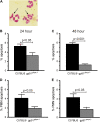Reactive oxygen species regulate neutrophil recruitment and survival in pneumococcal pneumonia
- PMID: 18202350
- PMCID: PMC2643216
- DOI: 10.1164/rccm.200707-990OC
Reactive oxygen species regulate neutrophil recruitment and survival in pneumococcal pneumonia
Abstract
Rationale: The role of NADPH oxidase activation in pneumonia is complex because reactive oxygen species contribute to both microbial killing and regulation of the acute pulmonary infiltrate. The relative importance of each role remains poorly defined in community-acquired pneumonia.
Objectives: We evaluated the contribution of NADPH oxidase-derived reactive oxygen species to the pathogenesis of pneumococcal pneumonia, addressing both the contribution to microbial killing and regulation of the inflammatory response.
Methods: Mice deficient in the gp91(phox) component of the phagocyte NADPH oxidase were studied after pneumococcal challenge.
Measurements and main results: gp91(phox)(-/-) mice demonstrated no defect in microbial clearance as compared with wild-type C57BL/6 mice. A significant increase in bacterial clearance from the lungs of gp91(phox)(-/-) mice was associated with increased numbers of neutrophils in the lung, lower rates of neutrophil apoptosis, and enhanced activation. Marked alterations in pulmonary cytokine/chemokine expression were also noted in the lungs of gp91(phox)(-/-) mice, characterized by elevated levels of tumor necrosis factor-alpha, KC, macrophage inflammatory protein-2, monocyte chemotactic protein-1, and IL-6. The greater numbers of neutrophils in gp91(phox)(-/-) mice were not associated with increased lung injury. Levels of neutrophil elastase in bronchoalveolar lavage were not decreased in gp91(phox)(-/-) mice.
Conclusions: During pneumococcal pneumonia, NADPH oxidase-derived reactive oxygen species are redundant for host defense but limit neutrophil recruitment and survival. Decreased NADPH oxidase-dependent reactive oxygen species production is well tolerated and improves disease outcome during pneumococcal pneumonia by removing neutrophils from the tight constraints of reactive oxygen species-mediated regulation.
Figures








References
-
- Restrepo MI, Mortensen EM, Pugh JA, Anzueto A. COPD is associated with increased mortality in patients with community-acquired pneumonia. Eur Respir J 2006;28:346–351. - PubMed
-
- Torres A, Dorca J, Zalacain R, Bello S, El-Ebiary M, Molinos L, Arevalo M, Blanquer J, Celis R, Iriberri M, et al. Community-acquired pneumonia in chronic obstructive pulmonary disease: a Spanish multicenter study. Am J Respir Crit Care Med 1996;154:1456–1461. - PubMed
-
- Dockrell DH, Marriott HM, Prince LR, Ridger VC, Ince PG, Hellewell PG, Whyte MK. Alveolar macrophage apoptosis contributes to pneumococcal clearance in a resolving model of pulmonary infection. J Immunol 2003;171:5380–5388. - PubMed
-
- Haslett C. Granulocyte apoptosis and its role in the resolution and control of lung inflammation. Am J Respir Crit Care Med 1999;160:S5–S11. - PubMed
-
- Ware LB, Matthay MA. The acute respiratory distress syndrome. N Engl J Med 2000;342:1334–1349. - PubMed
Publication types
MeSH terms
Substances
Grants and funding
LinkOut - more resources
Full Text Sources
Research Materials

